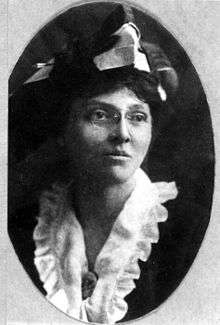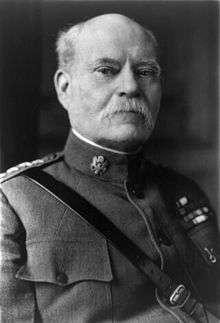Eleanora Knopf
Eleanora Frances Bliss Knopf (July 15, 1883 – January 21, 1974) was a geologist who worked for the United States Geological Survey (USGS) and did research in the Appalachians during the first two decades of the twentieth century. She studied at Bryn Mawr College, and earned a bachelor's degree in chemistry, a master's degree in geology, and a Ph.D. in geology in 1912. After completing her Ph.D., she accepted a position at the USGS, where she met and married the geologist Adolph Knopf, a professor at Yale University. She was the first American geologist to use the new technique of petrography which she pioneered in her life's work - the study of Stissing Mountain.[2]
Eleanora Frances Bliss Knopf | |
|---|---|
 1928 US Geological Survey ID Portrait | |
| Born | Eleanora Frances Bliss July 15, 1883[1] Rosemont, Pennsylvania[1] |
| Died | January 21, 1974 (aged 90)[1] Menlo Park, California[1] |
| Occupation | Geologist |
Early life

She was born in Rosemont, Pennsylvania on July 15, 1883. Her father was General Tasker Howard Bliss — a career soldier who became Chief of Staff of the US Army during the First World War as well as a principal representative of the United States in the Allied Councils. Her mother was Mary Anderson Bliss, and both sides of the family could trace their ancestry to settlers from England.[1] The Bliss family home was located near crystalline rocks which she later studied.[3] She married her husband, Adolph Knopf, in 1920. They did not have children of their own but she became a step-mother to his three children, who were already of school age at the time.[4][3]
Education
She attended Bryn Mawr College, where she earned her bachelor's degree in 1904. She was a student of a remarkable woman and geologist Florence Bascom, who had started the geology department there. Eleanora worked as a demonstrator in the geology lab at Bryn Mawr as well as an assistant curator in the Geological Museum at the college between 1904 and 1909. After two years at Berkeley (1910-1911), she returned to Bryn Mawr to work with Anna Jonas Stose on the study of the metamorphic rocks near the college— Stose and Bliss had followed Bascom into the study of petrology.[3] They presented their dissertation together and received doctorates in 1912.[4]
Career
Shortly after receiving a Ph.D. in geology from Bryn Mawr and passing the civil service examinations, she went to Washington, DC to assist as a geological aide to the United States Geological Survey (USGS) in 1912 and continued her work on the metamorphic rocks on sites around Bryn Mawr. She published several papers on her work in the area, often co-publishing with Anna Jonas Stose.[4] In 1913 she published her findings in the American Museum of Natural History of the first American sighting of mineral glaucophane, located in Pennsylvania[5] [6] which had never been found before in the east part of the Pacific Coast in the U.S.[7] In 1917, she was promoted to a geological assistant and later, in 1920, she became a full geologist. At the USGS, she met and married Adolph Knopf and at once moved to New Haven, where he taught at Yale University. She worked as a visiting lecturer at both Yale and Harvard.[8] She continued to work for the USGS until 1955 on a when actually employed basis. In 1925 she began studying the rocks of the Stissing Mountain region.[4] This study necessitated her attentiveness for the rest of her career. These presented unusual difficulty for examination purposes due to thrust faults. After searching overseas for new ways to precisely study the region, she settled upon the methods of Bruno Sander (from Innsbruck University) in which the fine structure of the rock was examined — the grains and the optical properties. She translated his work and used it for the following 40 years in the United States for her studies, mastering this new technique. This technique of petrography was new to US geology and her 1938 book on the subject, Structural Petrography, brought her much distinction. Eleanora Knopf was one of several American women geologists who spent time working in the Appalachians during the twentieth century. Though she was primarily a petrologist, she made astute observations concerning inequalities in erosion in catchments and hence the survival of palaeoforms in the landscape. [9] Although these observations were opposed to one of primary principles of geomorphology at the time, Bliss Knopf implied that remnant landforms should still survive for an extended period due to unequal erosion. In 1951, she joined Stanford University in geology department as a research associate.[10]
She continued to study the Stissing Mountain rocks until her retirement in 1955 but also made some expeditions to the Rocky Mountains. She aided her husband on his studies in the Rocky Mountains until his death in 1966. After his death, she devoted herself in completing his research regarding the Boulder Batholith but health complications aroused for her.[3] She lived to the age of 90 before dying in Menlo Park, California in 1974. She died of arteriosclerosis.[11]
References
- Aldrich 1980, p. 401.
- Oakes 2007, p. 408.
- Rodgers, John (February 1977). "Memorial to Eleanora Bliss Knopf" (PDF).
- Aldrich 1980, p. 402.
- Commire 2007, p. 1044.
- Helcon (2018). "Knopf, Eleanora Frances".
- Pennsylvania Conservation Heritage Project (2018). "Eleanora Frances Bliss Knopf".
- Helicon (2018). "Knopf, Eleanora Frances".
- Bourne 2008, p. 131.
- Bourne, Jennifer A. (2008). "Eleanora Bliss Knopf and unequal erosion".
- Aldrich 1980, p. 403.
Bibliography
- Oakes, Elizabeth H. (2007), Encyclopedia of World Scientists, InfoBase Publishing, ISBN 978-0816061587
- Rodgers, John ( 1977), " Memorial to Eleanora Bliss Knopf", Department of Geology and Geophysics, Yale University, New Haven, Connecticut, pp. 1–3.
- Aldrich, Michele L. (1980), "Knopf, Eleanora Frances Bliss", Notable American Women: The Modern Period, Harvard University Press, pp. 401–403, ISBN 9780674627338
- Aldrich, Michele L. (1993), "Women in Geology", Women of Science: Righting the Record, Indiana University Press, pp. 42–187, ISBN 9780253208132
- Commire, Anne (2007), "Knopf, Eleanora Bliss", Dictionary of Women Worldwide, Yorkin Publications, p. 1044, ISBN 9780787676766
- The Baldwin School: Eleanora Bliss Knopf, The Baldwin School, retrieved October 10, 2017
- Bourne, Jennifer A.; Twidale, C. Rowland (2008). "Eleanora Bliss Knopf and Unequal Erosion". Earth Sciences History. 27 (1): 132–133. doi:10.17704/eshi.27.1.y117972u01wx3587.
- Bourne, Jennifer A.; Twidale, C. Rowland (2008). "Eleanora Bliss Knopf and Unequal Erosion". Earth Sciences History. 27 (1): 131–135. doi:10.17704/eshi.27.1.y117972u01wx3587.